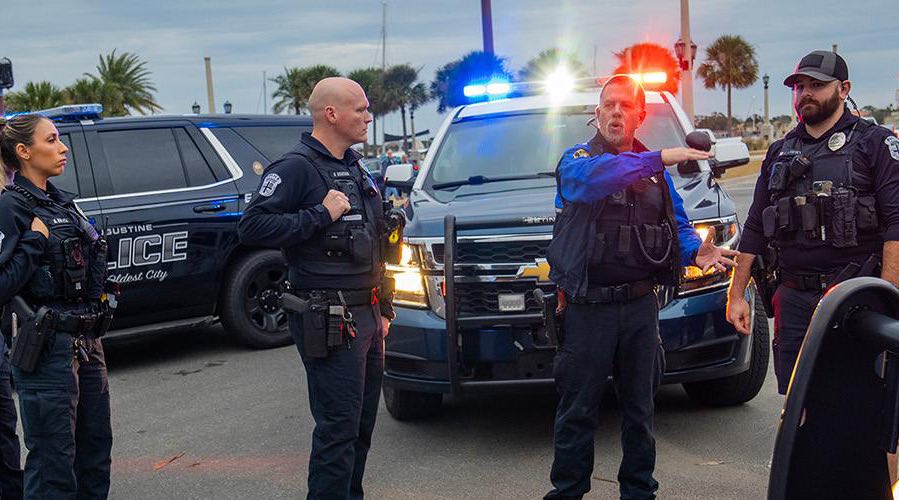
Citywide deployments of FirstNet make operations more efficient by creating seamless communication and data transfer among all response partners.
Three law enforcement officials shared with us how their citywide FirstNet deployment has been critical to ensuring everyone is informed and working together on a coordinated response. When I worked for the Phoenix Police Department, we had to create a dedicated radio channel to communicate with the fire department alone. These three agencies are using FirstNet to connect with multiple response partners.
St. Augustine sits below sea level on the east coast of Florida. The city has been hit by six Category 1 hurricanes in six years. When disasters hit St. Augustine, all public safety resources are needed to support response and mitigation efforts.
The police department liaises with the city’s public works department to set up detours and barricades, so public works employees can restore downed power lines and manage other utility issues.
“We’re tasked with getting the word out to people,” said Assistant Chief Anthony Cuthbert of the St. Augustine Police Department. “That includes using FirstNet to get resources in and out and working with command staff at the emergency operations center and incident command.”
A handful of city police and fire personnel first made the switch to FirstNet several years ago. By mid-2021, all city agencies had joined FirstNet. Interoperability on the network allows agency personnel to stay connected across the city, ensuring coordinated and reliable communications.
“Our sheriff's office and our police department have to work seamlessly, as do our two fire rescue units, because they're really working as one,” explained John Regan, St. Augustine City Manager. “This one element of communication allows us to use the best resources of both the county and the city.”
The city of Annapolis is the capitol of Maryland, home to the U.S. Naval Academy, and sits just 30 miles east of Washington, D.C. The city is no stranger to high-profile events. They’ve hosted governors’ inaugurations, presidential visits, diplomat visits, and tens of thousands of fans for the Naval Academy’s home football games.
That’s a big reason why Annapolis rolled out FirstNet citywide, connecting the Annapolis Police Department, the Office of Emergency Management, the Transportation Department, Public Works, and Recreation and Parks.
Sergeant Ricky Truitt from the Annapolis Police Department, who has overseen the deployment of FirstNet citywide, said that the city relies on FirstNet for dependable communications among all city agencies. “It’s very important to have situational awareness during our emergencies,” he said. “Knowing where our [public works trucks] are [and that they are] connected and receiving reports from our emergency operations centers is paramount to being able to provide quality service to our citizens here in Annapolis.”
FirstNet’s interoperability across city agencies allows police commanders to make instant decisions by quickly receiving input from the field. For example, all of Annapolis’ public transit buses have security cameras and GPS connected via FirstNet, so when there is an accident or security incident, the city is able to consult video feeds to coordinate an appropriate response.
“What FirstNet provides is the ability to communicate with all stakeholders,” explained Annapolis Police Chief Edward Jackson. “Whether you’re talking about public works, the Office of Emergency Management, any city or state agency—it gives [officers] the ability to communicate with them in real time.”
The Casper Police Department in Wyoming was one of the first in the nation to operate on FirstNet. They were trailblazers looking to maintain public safety communications during the solar eclipse of 2017. Casper was a prime spot for viewing the eclipse and more than 1 million visitors flooded the city, which has a normal population of 58,000.
Scott Hoffman, Police Technologies Manager for the Casper Police Department, said that despite connectivity dropping on their commercial devices, “On the FirstNet side, we were able to keep that connection live, giving our officers the ability to communicate in vehicles and on cellular devices.”
He says it’s important for partner agencies to be on FirstNet. “The more people we have on the network, the better the communication is going to be. That interoperability is the biggest factor.”
The police department continues to use FirstNet for its communications. More recently, Casper’s IT department has implemented FirstNet for public services, with GPS devices on snowplows and garbage trucks. This allows city management to know when snowplows are up or down and when to re-route trash trucks during an incident.
FirstNet has also been useful for communicating with partners from outside the city. “We've had other agencies come into our jurisdiction for agency assist. We’ve provided them with a cellular device to allow them to communicate back and forth with us without having any interference,” he said. “Those are the types of things we've been trying to implement … showing what [FirstNet] can do and where we're taking it.”
